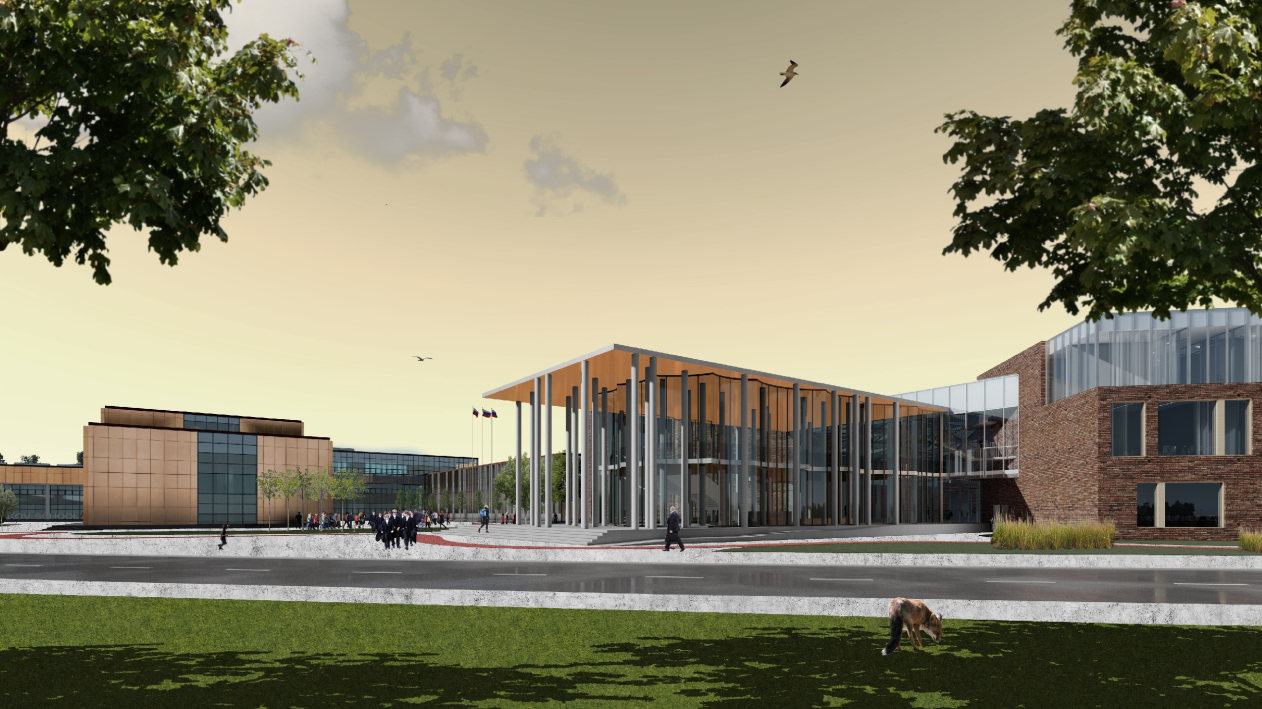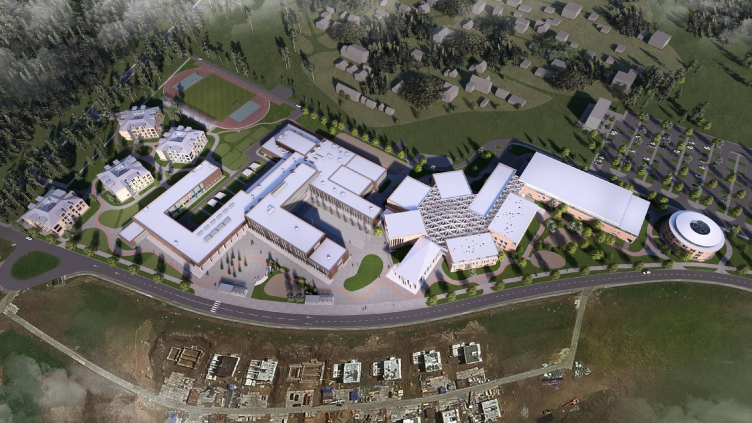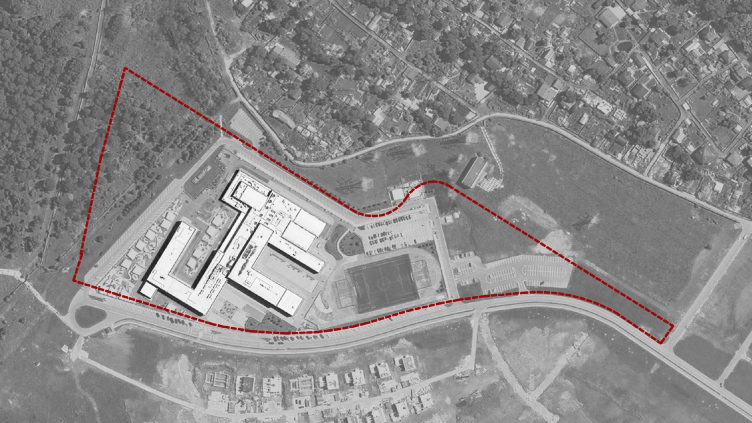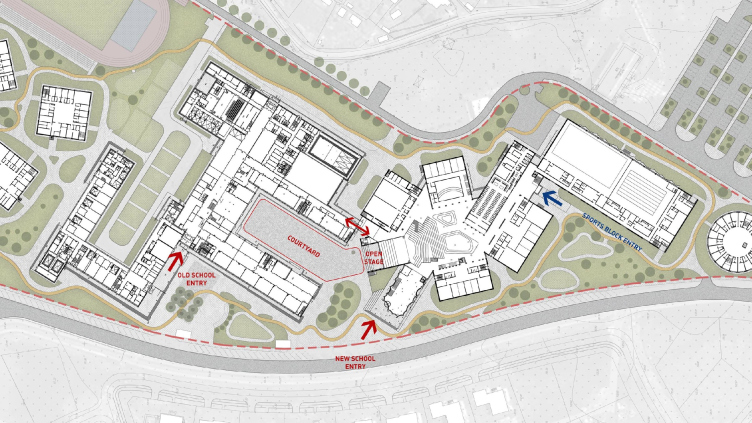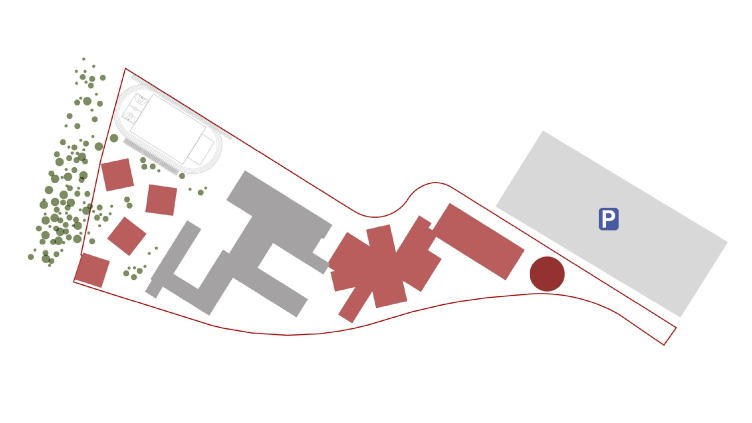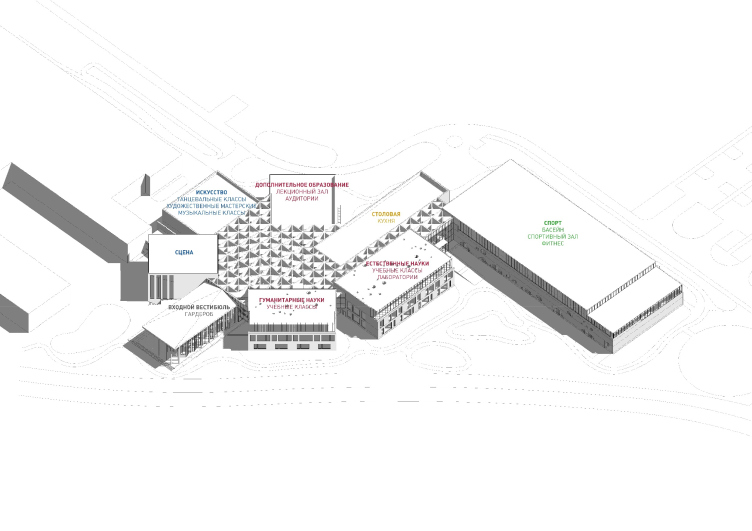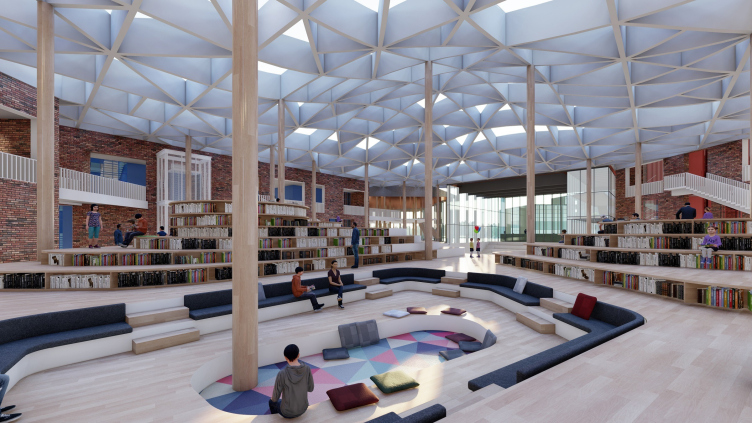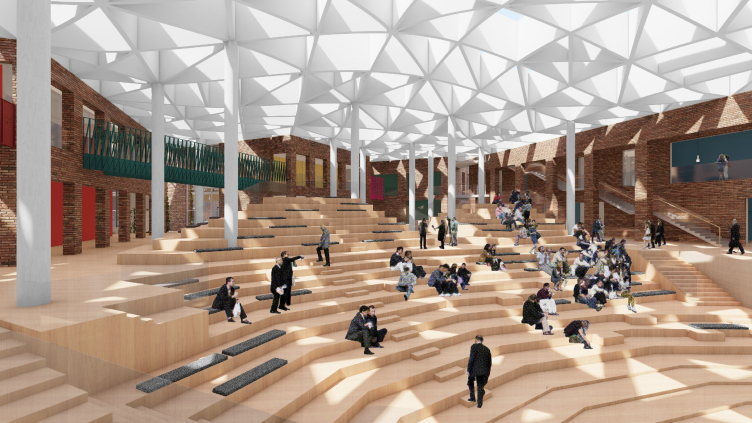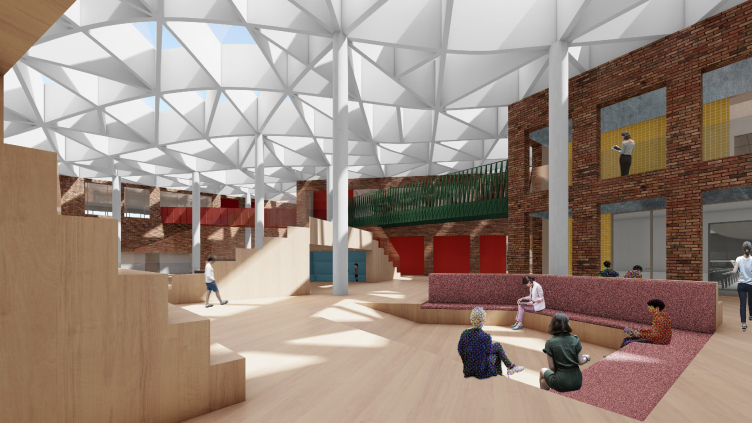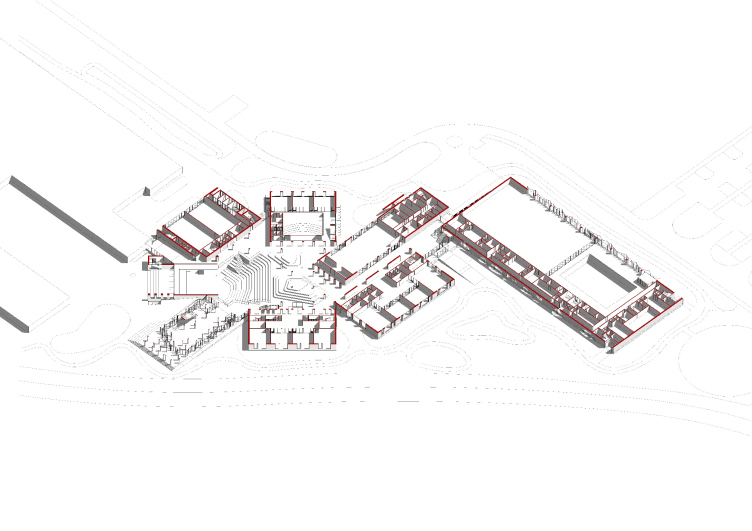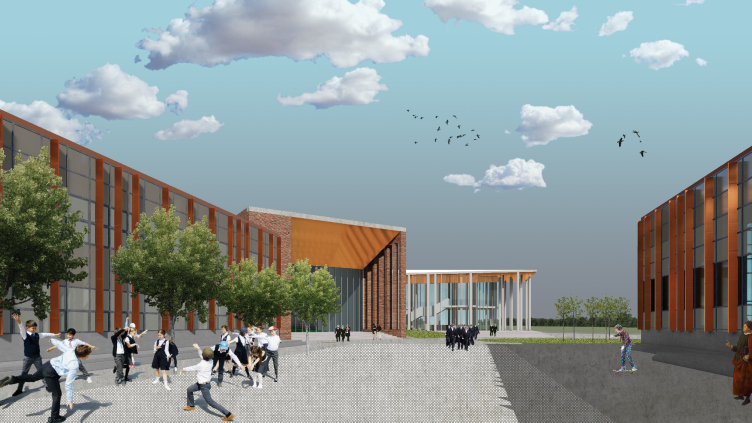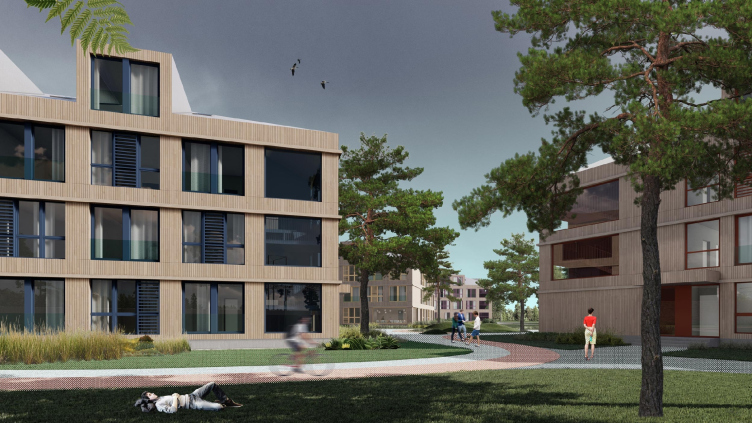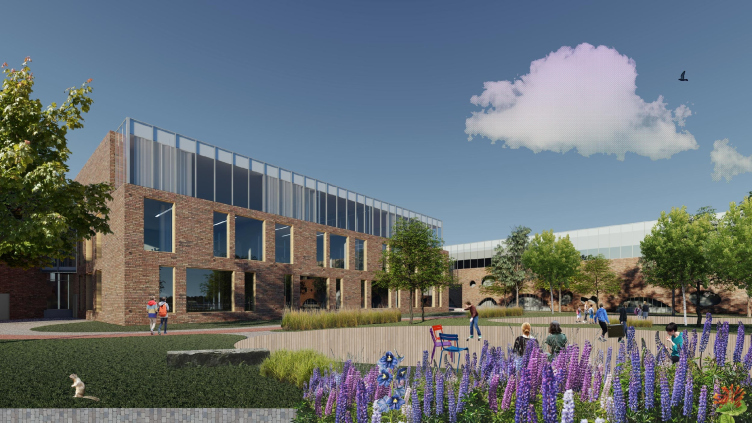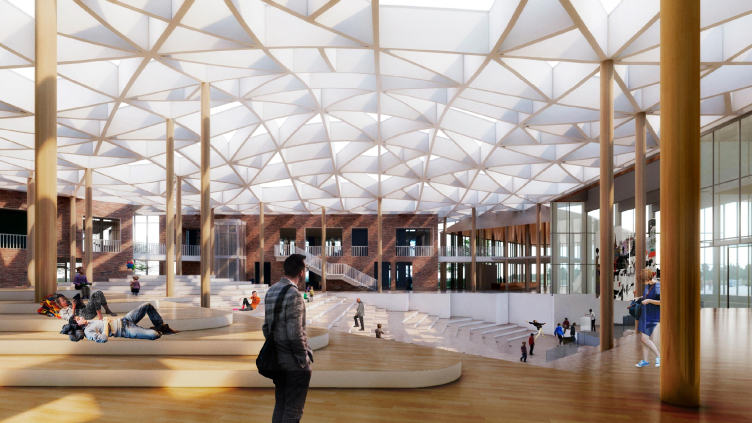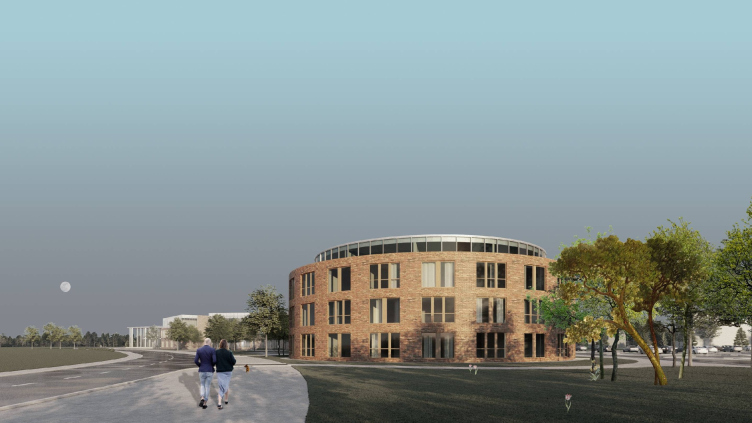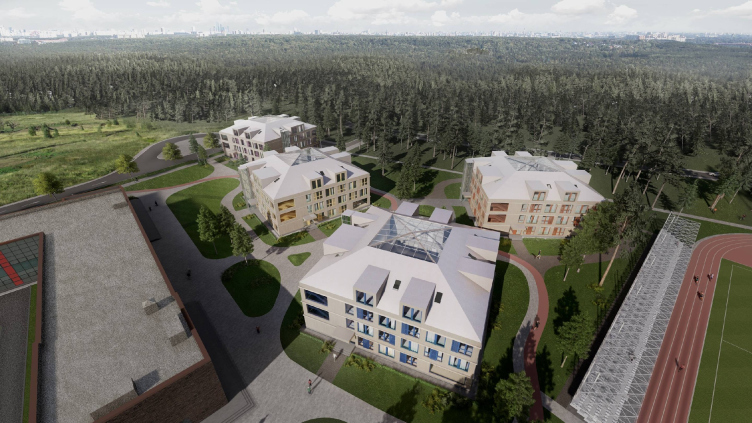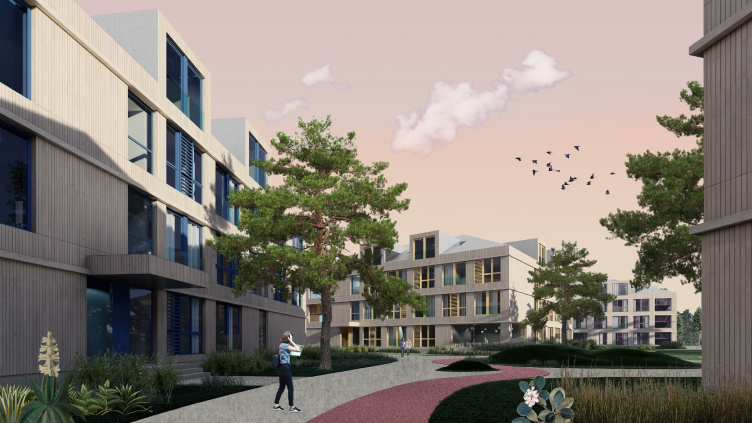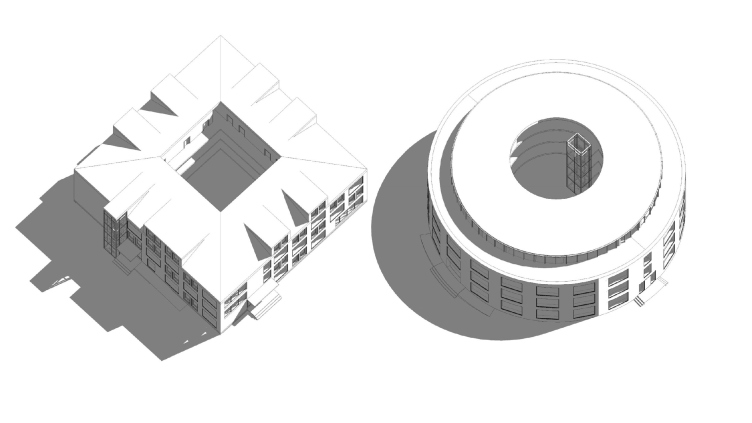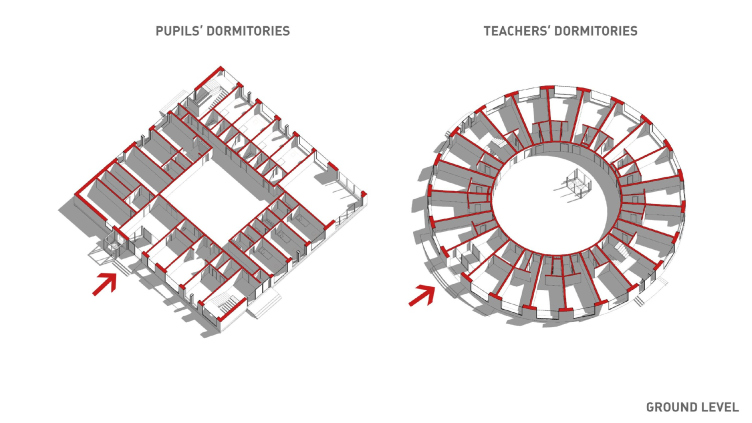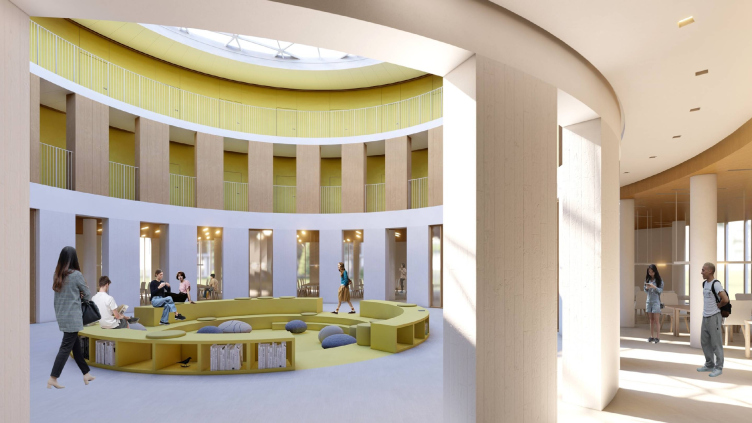“Maya invests so much enthusiasm, intellect, and energy into this initiative of hers – Nikita Yavein says – That you can arguably consider her to be not just the mastermind of this project but also the coauthor of our architectural solution”. We must note here that, for Nikita Yavein, it’s yet another unique school, after Boris Eifman Dance Academy, Saint Petersburg Graduate School of Management, and “Sirius”. Focusing on the most advanced trends in today’s educational process – “multiplication of communications” and “mixing of layers” – brought about a solution based on a multifunctional atrium, a technique that is quite frequently used by Studio 44. The complexities of the land site in Moscow area’s Odintsovo became in this particular instance the starting point for a structure that became as complex as elegant in its logic, imbued, in addition with the “new school” ideology.
E.M. Primakov Gymnasium, 2nd stage
Copyright: © Studio 44
E.M. Primakov Gymnasium, 2nd stage. The land site
Copyright: © Studio 44
Currently, the gymnasium is hosted in a three-story building, highly developed and complex in terms of its construction blueprint. Standing against the background of the village of Razdory, consisting predominantly of small private housing projects, it presents a fundamentally new scale of construction. The new building, which will be needed for the development of the gymnasium, is meant, according to the architects’ idea, to introduce a third construction scale – a transitional link between the finely divided private construction and the existing volume.
E.M. Primakov Gymnasium, 2nd stage. The scale
Copyright: © Studio 44
“Fitting the building into this land site turned out to be more challenging that it was on the Nevsky Prospect – Nikita Yavein shares – We built quite a lot of projects in the historical center of Saint Petersburg, dealing with all sorts of restrictions, but it was the first time that we had to solve so many issues with engineering networks, when small owners struggled for literally every square meter of this land. These problems made us change the project several times”. Eventually, the construction blueprint shrank and took on a complex shape, inside of which the architects were not only able to place everything that they intended to, avoiding over-saturation, but also positioned the functions in an aesthetically pleasing way, observing a certain hierarchy of the educational process.
E.M. Primakov Gymnasium, 2nd stage. The master plan
Copyright: © Studio 44
E.M. Primakov Gymnasium, 2nd stage. The scale
Copyright: © Studio 44
“We tried to make the most of the geometry of this space and its structure based on the ideology of the modern educational process. I am referring to socialization spaces and spaces for communication, to which the advanced schools attach a lot of importance during even the early stages of education. Children communicate with one another, and they also learn from one another – no more isolation, and it’s also OK if they do make some noise. This playful education format, as well as informal communication with the teachers, is conducive to self-education. And our task was to create the necessary environment for that by means of architecture” – Nikita Yavein explains.
E.M. Primakov Gymnasium, 2nd stage. The axonometric drawing
Copyright: © Studio 44
It stands to reason that the space for such total communication, just as the planning center of the school, is the atrium. In addition to the conceptual purpose, it also serves a utilitarian one: a few days in a year it must host about 1300 people – the children, the guests, and the sponsors, coming to the gala events. Building for that purpose a separate auditorium, which would have stood locked up almost 360 days a year, was not an option.
E.M. Primakov Gymnasium, 2nd stage. The atrium
Copyright: © Studio 44
Primakov School, 2nd stage. The atrium
Copyright: © Studio 44
Now, however, this spatial nucleus attracts the functional blocks, scattered “chaotically” around it, expressing this “medium scale” found by the architects. Each of these blocks has a “face” of its own. Science, humanities, fine arts, as well as the entrance lobby, the cafeteria, and the main stage, are all executed with an individual set of architectural techniques, and composition-wise the new building will look like a congregation of several different ones. Their “chaotic arrangement” in actuality has a strict hierarchy encoded in it: the importance of the role that this or that function plays in the educational process will define the “degree of intrusion” of this function into the atrium. For example, Science and Sports look slightly secluded, while the Cafeteria and Humanities are almost completely open to the atrium.
E.M. Primakov Gymnasium, 2nd stage. The atrium
Copyright: © Studio 44
E.M. Primakov Gymnasium, 2nd stage. The atrium
Copyright: © Studio 44
“We designed these volumes, based on the geometry of the land site, rather rigid. Then we determined the degree of their “intrusion” into the atrium, whose size we simply could not “blow up”, and tried to interpret this as some kind of landscape. What we ultimately got was a little village or a little town, whose main facades overlook the “main square”, i.e. the auditorium. These facades are belted by galleries that provide the connection between the premises on the second level, turning into the “spectator balconies” during the events” – comments Ivan Kozhin, the chief architect of the project.
E.M. Primakov Gymnasium, 2nd stage. The axonometric drawing
Copyright: © Studio 44
The main element of the landscape is the irregular-shaped staircase, which is also the amphitheater, opening up with its complex geometry towards the stage block. This “forum” staircase is a technique not just popular but virtually obligatory in modern western schools. In this gymnasium, however, it is also laden with its inner function: it is a library with an open book stock, peripheral “hills”, and “grottos” in the shape of terraced “ziggurats”, where one can study and read undisturbed. This extended space is covered by a spongy vesicular structure resting on a forest of slender columns – it looks as if it spreads out and joins the blocks to become a single whole.
E.M. Primakov Gymnasium, 2nd stage. The lobby
Copyright: © Studio 44
E.M. Primakov Gymnasium, 2nd stage. The academic building
Copyright: © Studio 44
Planning-wise, the thematic blocks are rather autonomous, and have individual solutions. The Humanities block, for example, is designed as a congregation of small auditoriums with a small lounge of their own. The Fine Arts block contains a system or halls with upper lights for dancing, playing music, and painting. The habitual corridors between them are nonexistent: the spatial connection is performed directly through the atrium. All of the maintenance functions stay in the basement floor: the utility lines, the cloakrooms, and the bathrooms. The relatively independent third floor is occupied by the teachers’ rooms, and the Principal’s office.
E.M. Primakov Gymnasium, 2nd stage. The academic building
Copyright: © Studio 44
E.M. Primakov Gymnasium, 2nd stage. The academic building
Copyright: © Studio 44
Besides the indoor “square”, the complex also has an outdoor one – the courtyard of the existing gymnasium building. In the solution proposed by Studio 44, it takes on a certain degree of solemnity, which entitles it to a right to be called a square. Here we see the “porticos” of the lobby and stage blocks, which connect the school’s outdoor and indoor spaces.
The grand lobby is essentially a paraphrase of the antique peripter, which liberally “scatters” the columns around the light glass volume and thus indicates that the educational process here is far from classical. The Stage block, situated nearby (and the Stage can work both for the indoor and the outdoor squares), by contrast, looks very massive because it is made of brick. It goes outside in a powerful flare in the spirit of the Italian rationalists Adalberto Libera or Giuseppe Terragni. At the same time, however, the portal is interpreted asymmetrically, as if hinting at some “democratization” of classic, freedom of interpretation, and the absence of habitual classic patterns in this school. For example, the glazed volume of the staircase on the one side is echoed by an array of columns on the other.
E.M. Primakov Gymnasium, 2nd stage. The lobby
Copyright: © Studio 44
E.M. Primakov Gymnasium, 2nd stage. The teachers′ dormitory
Copyright: © Studio 44
In spite of the vastly different techniques, all of these solutions look as if they comply with a single code: this a deliberately increased scale that emphasizes its pylons, and a contrastive combination of brick and glass. The most remote Sports block is something like a transition to the round building of the teachers’ dormitory that stands at the edge of the site. It gets circular windows and windows whose outlines resemble the “thermal” ones and look as if they were preparing the observer for the appearance of a “radical” mini-Coliseum.
E.M. Primakov Gymnasium, 2nd stage. The students′ dormitory
Copyright: © Studio 44
E.M. Primakov Gymnasium, 2nd stage. The students′ dormitory
Copyright: © Studio 44
Situated in the northern part of the territory, the students’ dormitories are more traditional and rectangular. While the “Coliseum” is interpreted as a large-scale “Roman” form, the architecture of these square-type dormitories is ostentatiously modern. It has both “countryside” look about it, as well as something Scandinavian, probably inspired by the special kind of wooden board, widely used in the settlement. But then again, the inner structure is the same everywhere around here: the premises are grouped around small-sizes lounges or atriums, overlooking them with galleries or balconies.
E.M. Primakov Gymnasium, 2nd stage. The complex of dormitories
Copyright: © Studio 44
E.M. Primakov Gymnasium, 2nd stage. The complex of dormitories
Copyright: © Studio 44
E.M. Primakov Gymnasium, 2nd stage. The teachers′ dormitory
Copyright: © Studio 44
The environment that urges the students to communicate and interact with each other is not limited to the walls of the complex and spills over to the surrounding landscape, pierced with pedestrian and bicycle trails. Presenting the Studio 44 project at the recent Zodchestvo Festival, the chief architect of the Moscow area, Alexandra Kuzmina, noted that solving this challenging task and making the project fit in so nicely with the context was only possible by finding the right scale of things, which the architects were able to do quite successfully. Yet another proof of that is the fact that the project got shortlisted by WAF, a festival where Nikita Yavein is spotted with unfailing regularity.

